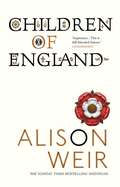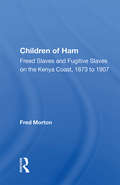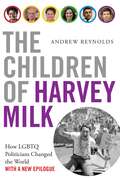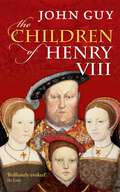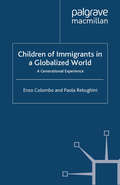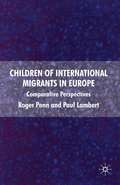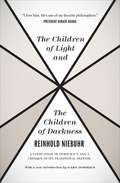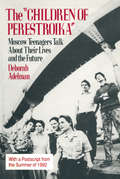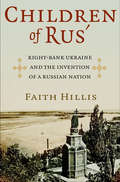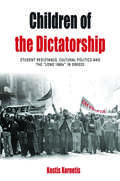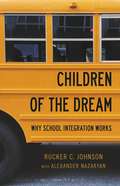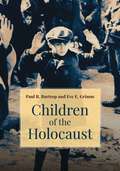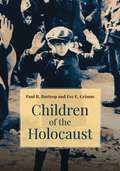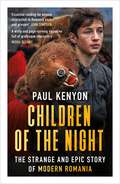- Table View
- List View
Children Of England: The Heirs of King Henry VIII 1547-1558
by Alison WeirWhen Henry VIII died in 1547, he left three highly intelligent children to succeed him in turn, to be followed, if their lines failed, by the descendants of his sister, Mary Tudor.Children of England begins at the point where Alison Wier's bestseller, The Six Wives of Henry VIII came to an end, and covers the period until Elizabeth succeeded to the throne in 1558. Her interest is in the characters and relationships with Henry's four heirs. Making use of a huge variety of contemporary sources, she brings to life one of the most extraordinary periods of English history, when each of Henry's heirs was potentially the tool of powerful political or religious figures, and when the realm was seething with intrigue and turbulent change.
Children Of Ham: Freed Slaves And Fugitive Slaves On The Kenya Coast, 1873 To 1907
by Fred MortonChildren of Ham: Freed Slaves and Fugitives Slaves on the Kenya Coast,I 873 to 1907 is a chronological account of the repeated bids for freedom made by slaves and ex-slaves on the Kenya coast and of the obstacles placed in their way by the British, the Busaidi Arabs, and the peoples of the coast. Efforts to escape slavery are as old as slavery itself on the Kenya coast, but the principal story begins in 1873, when Britain pressured the sultan of Zanzibar to abolish the ocean-going slave trade. Thereafter, political and military conflict intensified on the coast, while opportunities for slaves to escape increased accordingly. This period, ending roughly with the abolition of the legal status of slavery in 1907, corresponds to the imperial scramble from its earliest stages to the effective establishment of European rule.
Children Of Ham: Freed Slaves And Fugitive Slaves On The Kenya Coast, 1873 To 1907
by Fred MortonChildren of Ham: Freed Slaves and Fugitives Slaves on the Kenya Coast,I 873 to 1907 is a chronological account of the repeated bids for freedom made by slaves and ex-slaves on the Kenya coast and of the obstacles placed in their way by the British, the Busaidi Arabs, and the peoples of the coast. Efforts to escape slavery are as old as slavery itself on the Kenya coast, but the principal story begins in 1873, when Britain pressured the sultan of Zanzibar to abolish the ocean-going slave trade. Thereafter, political and military conflict intensified on the coast, while opportunities for slaves to escape increased accordingly. This period, ending roughly with the abolition of the legal status of slavery in 1907, corresponds to the imperial scramble from its earliest stages to the effective establishment of European rule.
The Children of Harvey Milk: How LGBTQ Politicians Changed the World
by Andrew ReynoldsPart political thriller, part meditation on social change, part love story, The Children of Harvey Milk tells the epic stories of courageous men and women around the world who came forward to make their voices heard during the struggle for equal rights. Featuring LGBTQ icons from America to Ireland, Britain to New Zealand; Reynolds documents their successes and failures, heartwarming stories of acceptance and heartbreaking stories of ostracism, demonstrating the ways in which an individual can change the views and voting behaviors of those around them. The book also includes rare vignettes of LGBTQ leaders in Africa, Asia, Latin America and the Caribbean who continue to fight for equality in spite of threats, violence, and homophobia. A touchstone narrative of the tumultuous journey towards LGBTQ rights, The Children of Harvey Milk is a must-read for anyone with an interest in social change. Updated in paperback, this new edition accounts for developments such as the US presidential candidacy of Pete Buttigieg.
The Children of Harvey Milk: How LGBTQ Politicians Changed the World
by Andrew ReynoldsPart political thriller, part meditation on social change, part love story, The Children of Harvey Milk tells the epic stories of courageous men and women around the world who came forward to make their voices heard during the struggle for equal rights. Featuring LGBTQ icons from America to Ireland, Britain to New Zealand; Reynolds documents their successes and failures, heartwarming stories of acceptance and heartbreaking stories of ostracism, demonstrating the ways in which an individual can change the views and voting behaviors of those around them. The book also includes rare vignettes of LGBTQ leaders in Africa, Asia, Latin America and the Caribbean who continue to fight for equality in spite of threats, violence, and homophobia. A touchstone narrative of the tumultuous journey towards LGBTQ rights, The Children of Harvey Milk is a must-read for anyone with an interest in social change. Updated in paperback, this new edition accounts for developments such as the US presidential candidacy of Pete Buttigieg.
The Children of Henry VIII
by John GuyBehind the façade of politics and pageantry at the Tudor court, there was a family drama. Nothing drove Henry VIII, England's wealthiest and most powerful king, more than producing a legitimate male heir and so perpetuating his dynasty. To that end, he married six wives, became the subject of the most notorious divorce case of the sixteenth century, and broke with the pope, all in an age of international competition and warfare, social unrest and growing religious intolerance and discord. Henry fathered four living children, each by a different mother. Their interrelationships were often scarred by jealously, mutual distrust, sibling rivalry, even hatred. Possessed of quick wits and strong wills, their characters were defined partly by the educations they received, and partly by events over which they had no control. Henry Fitzroy, Duke of Richmond, although recognized as the king's son, could never forget his illegitimacy. Edward died while still in his teens, desperately plotting to exclude his half-sisters from the throne. Mary's world was shattered by her mother's divorce and her own unhappy marriage. Elizabeth was the most successful, but also the luckiest. Even so, she lived with the knowledge that her father had ordered her mother's execution, was often in fear of her own life, and could never marry the one man she truly loved. Henry's children idolized their father, even if they differed radically over how to perpetuate his legacy. To tell their stories, John Guy returns to the archives, drawing on a vast array of contemporary records, personal letters, and first-hand accounts.
Children of Immigrants in a Globalized World: A Generational Experience (Migration, Diasporas and Citizenship)
by E. Colombo P. RebughiniThis book explores the generational experience of children of immigrants growing up in an increasingly globalized and interconnected world, comparing the lives of Mediterranean youths with those from America and Northern Europe.
Children of Intercountry Adoptions in School: A Primer for Parents and Professionals
by Ruth Lyn MeeseChildren of intercountry adoption have complex histories that place them at high risk for difficulty or failure in school. Teachers and other school professionals rarely know how to test them, teach them, or meet their needs. This volume explains those needs and offers guidelines and suggestions for maximizing the educational performance of these children and helping them to meet their potential.The volume includes research on children adopted from several countries, including Russia and former Soviet states, Romania, and China. Content includes information from adoption literature on English as a Second Language classes, as well as special education law and research. The volume also presents the stories of real children adopted from Romania, Russia, and China, along with their parents and their interactions with schools in the United States.
Children of International Migrants in Europe: Comparative Perspectives
by R. Penn P. LambertThis book is a comparative analysis of children of international migrants in Britain, France and Germany, using survey data from the EFFNATIS project. By analysing data on linguistic, structural, political, religious and socio-cultural behaviour, it offers exciting new evidence on sociological models of immigrant incorporation.
The Children of Light and the Children of Darkness: A Vindication of Democracy and a Critique of Its Traditional Defense
by Reinhold NiebuhrThe Children of Light and the Children of Darkness, first published in 1944, is considered one of the most profound and relevant works by the influential theologian Reinhold Niebuhr, and certainly the fullest statement of his political philosophy. Written and first read during the prolonged, tragic world war between totalitarian and democratic forces, Niebuhr’s book took up the timely question of how democracy as a political system could best be defended. Most proponents of democracy, Niebuhr claimed, were “children of light,” who had optimistic but naïve ideas about how society could be rid of evil and governed by enlightened reason. They needed, he believed, to absorb some of the wisdom and strength of the “children of darkness,” whose ruthless cynicism and corrupt, anti-democratic politics should otherwise be repudiated. He argued for a prudent, liberal understanding of human society that took the measure of every group’s self-interest and was chastened by a realistic understanding of the limits of power. It is in the foreword to this book that he wrote, “Man’s capacity for justice makes democracy possible; but man’s inclination to injustice makes democracy necessary.” This edition includes a new introduction by the theologian and Niebuhr scholar Gary Dorrien in which he elucidates the work’s significance and places it firmly into the arc of Niebuhr’s career.
The Children of Light and the Children of Darkness: A Vindication of Democracy and a Critique of Its Traditional Defense
by Reinhold NiebuhrThe Children of Light and the Children of Darkness, first published in 1944, is considered one of the most profound and relevant works by the influential theologian Reinhold Niebuhr, and certainly the fullest statement of his political philosophy. Written and first read during the prolonged, tragic world war between totalitarian and democratic forces, Niebuhr’s book took up the timely question of how democracy as a political system could best be defended. Most proponents of democracy, Niebuhr claimed, were “children of light,” who had optimistic but naïve ideas about how society could be rid of evil and governed by enlightened reason. They needed, he believed, to absorb some of the wisdom and strength of the “children of darkness,” whose ruthless cynicism and corrupt, anti-democratic politics should otherwise be repudiated. He argued for a prudent, liberal understanding of human society that took the measure of every group’s self-interest and was chastened by a realistic understanding of the limits of power. It is in the foreword to this book that he wrote, “Man’s capacity for justice makes democracy possible; but man’s inclination to injustice makes democracy necessary.” This edition includes a new introduction by the theologian and Niebuhr scholar Gary Dorrien in which he elucidates the work’s significance and places it firmly into the arc of Niebuhr’s career.
The Children of Light and the Children of Darkness: A Vindication of Democracy and a Critique of Its Traditional Defense
by Reinhold NiebuhrThe Children of Light and the Children of Darkness, first published in 1944, is considered one of the most profound and relevant works by the influential theologian Reinhold Niebuhr, and certainly the fullest statement of his political philosophy. Written and first read during the prolonged, tragic world war between totalitarian and democratic forces, Niebuhr’s book took up the timely question of how democracy as a political system could best be defended. Most proponents of democracy, Niebuhr claimed, were “children of light,” who had optimistic but naïve ideas about how society could be rid of evil and governed by enlightened reason. They needed, he believed, to absorb some of the wisdom and strength of the “children of darkness,” whose ruthless cynicism and corrupt, anti-democratic politics should otherwise be repudiated. He argued for a prudent, liberal understanding of human society that took the measure of every group’s self-interest and was chastened by a realistic understanding of the limits of power. It is in the foreword to this book that he wrote, “Man’s capacity for justice makes democracy possible; but man’s inclination to injustice makes democracy necessary.” This edition includes a new introduction by the theologian and Niebuhr scholar Gary Dorrien in which he elucidates the work’s significance and places it firmly into the arc of Niebuhr’s career.
The Children of Light and the Children of Darkness: A Vindication of Democracy and a Critique of Its Traditional Defense
by Reinhold NiebuhrThe Children of Light and the Children of Darkness, first published in 1944, is considered one of the most profound and relevant works by the influential theologian Reinhold Niebuhr, and certainly the fullest statement of his political philosophy. Written and first read during the prolonged, tragic world war between totalitarian and democratic forces, Niebuhr’s book took up the timely question of how democracy as a political system could best be defended. Most proponents of democracy, Niebuhr claimed, were “children of light,” who had optimistic but naïve ideas about how society could be rid of evil and governed by enlightened reason. They needed, he believed, to absorb some of the wisdom and strength of the “children of darkness,” whose ruthless cynicism and corrupt, anti-democratic politics should otherwise be repudiated. He argued for a prudent, liberal understanding of human society that took the measure of every group’s self-interest and was chastened by a realistic understanding of the limits of power. It is in the foreword to this book that he wrote, “Man’s capacity for justice makes democracy possible; but man’s inclination to injustice makes democracy necessary.” This edition includes a new introduction by the theologian and Niebuhr scholar Gary Dorrien in which he elucidates the work’s significance and places it firmly into the arc of Niebuhr’s career.
Children of Other Worlds: Exploitation in the Global Market
by Jeremy SeabrookMore than 40,000 children die daily in the developing world from avoidable sickness and disease. Tens of millions of children labour in mines, mills and sweatshops, or scavenge for a living on city streets and dumps. In the so-called developed world, children's lives are similarly blighted by drugs, alcohol, sexual abuse and violence. *BR**BR*Children of the rich are unhealthily obsessed with consumerist desires while children of the poor suffer from lack of opportunity. The global market is responsible for both of these ills.*BR**BR*In Children of Other Worlds Jeremy Seabrook examines the international exploitation of children and exposes the hypocrisy, piety and moral blindness that have informed so much of the debate in the West on the rights of the child. Seabrook insists that the whole question of protecting children's rights must take into consideration the structural abuses of humanity that are inherent in globalisation.
The Children of Perestroika: Moscow Teenagers Talk About Their Lives and the Future
by Deborah AdelmanThis work provides an examination of US refugee policy since the 1960s, particularly as it has been applied to Cuba, Haiti and Central America. The authors also address world-wide refugee problems, proposing ideas for the 21st century.
The Children of Perestroika: Moscow Teenagers Talk About Their Lives and the Future
by Deborah AdelmanThis work provides an examination of US refugee policy since the 1960s, particularly as it has been applied to Cuba, Haiti and Central America. The authors also address world-wide refugee problems, proposing ideas for the 21st century.
The Children of Perestroika Come of Age: Young People of Moscow Talk About Life in the New Russia
by Deborah AdelmanDemonstrates the relevance, rigor, and creativity of interpretive research methodologies for political science and its various sub-fields. Designed for use in a course on interpretive research methods, this book situates methods questions within the context of methodological questions - the character of social realities and their "know-ability."
The Children of Perestroika Come of Age: Young People of Moscow Talk About Life in the New Russia
by Deborah AdelmanDemonstrates the relevance, rigor, and creativity of interpretive research methodologies for political science and its various sub-fields. Designed for use in a course on interpretive research methods, this book situates methods questions within the context of methodological questions - the character of social realities and their "know-ability."
Children of Rus': Right-Bank Ukraine and the Invention of a Russian Nation
by Faith HillisIn Children of Rus’, Faith Hillis recovers an all but forgotten chapter in the history of the tsarist empire and its southwestern borderlands. The right bank, or west side, of the Dnieper River—which today is located at the heart of the independent state of Ukraine—was one of the Russian empire’s last territorial acquisitions, annexed only in the late eighteenth century. Yet over the course of the long nineteenth century, this newly acquired region nearly a thousand miles from Moscow and St. Petersburg generated a powerful Russian nationalist movement. Claiming to restore the ancient customs of the East Slavs, the southwest’s Russian nationalists sought to empower the ordinary Orthodox residents of the borderlands and to diminish the influence of their non-Orthodox minorities. Right-bank Ukraine would seem unlikely terrain to nourish a Russian nationalist imagination. It was among the empire’s most diverse corners, with few of its residents speaking Russian as their native language or identifying with the culture of the Great Russian interior. Nevertheless, as Hillis shows, by the late nineteenth century, Russian nationalists had established a strong foothold in the southwest’s culture and educated society; in the first decade of the twentieth, they secured a leading role in local mass politics. By 1910, with help from sympathetic officials in St. Petersburg, right-bank activists expanded their sights beyond the borderlands, hoping to spread their nationalizing agenda across the empire.Exploring why and how the empire’s southwestern borderlands produced its most organized and politically successful Russian nationalist movement, Hillis puts forth a bold new interpretation of state-society relations under tsarism as she reconstructs the role that a peripheral region played in attempting to define the essential characteristics of the Russian people and their state.
Children of the Dictatorship: Student Resistance, Cultural Politics and the 'Long 1960s' in Greece (Protest, Culture & Society #10)
by Kostis KornetisPutting Greece back on the cultural and political map of the “Long 1960s,” this book traces the dissent and activism of anti-regime students during the dictatorship of the Colonels (1967-74). It explores the cultural as well as ideological protest of Greek student activists, illustrating how these “children of the dictatorship” managed to re-appropriate indigenous folk tradition for their “progressive” purposes and how their transnational exchange molded a particular local protest culture. It examines how the students’ social and political practices became a major source of pressure on the Colonels’ regime, finding its apogee in the three day Polytechnic uprising of November 1973 which laid the foundations for a total reshaping of Greek political culture in the following decades.
Children of the Dream: Why School Integration Works
by Rucker C. JohnsonAn acclaimed economist reveals that school integration efforts in the 1970s and 1980s were overwhelmingly successful -- and argues that we must renew our commitment to integration for the sake of all Americans We are frequently told that school integration was a social experiment doomed from the start. But as Rucker C. Johnson demonstrates in Children of the Dream, it was, in fact, a spectacular achievement. Drawing on longitudinal studies going back to the 1960s, he shows that students who attended integrated and well-funded schools were more successful in life than those who did not -- and this held true for children of all races. Yet as a society we have given up on integration. Since the high point of integration in 1988, we have regressed and segregation again prevails. Contending that integrated, well-funded schools are the primary engine of social mobility, Children of the Dream offers a radical new take on social policy. It is essential reading in our divided times.
Children of the Holocaust
by Paul R. Bartrop Eve E. GrimmThis important reference work highlights a number of disparate themes relating to the experience of children during the Holocaust, showing their vulnerability and how some heroic people sought to save their lives amid the horrors perpetrated by the Nazi regime.This book is a comprehensive examination of the people, ideas, movements, and events related to the experience of children during the Holocaust. They range from children who kept diaries to adults who left memoirs to others who risked (and, sometimes, lost) their lives in trying to rescue Jewish children or spirit them away to safety in various countries. The book also provides examples of the nature of the challenges faced by children during the years before and during World War II. In many cases, it examines the very act of children's survival and how this was achieved despite enormous odds.In addition to more than 125 entries, this book features 10 illuminating primary source documents, ranging from personal accounts to Nazi statements regarding what the fate of Jewish children should be to statements from refugee leaders considering how to help Jewish children after World War II ended. These documents offer fascinating insights into the lives of students during the Holocaust and provide students and researchers with excellent source material for further research.
Children of the Holocaust
by Paul R. Bartrop Eve E. GrimmThis important reference work highlights a number of disparate themes relating to the experience of children during the Holocaust, showing their vulnerability and how some heroic people sought to save their lives amid the horrors perpetrated by the Nazi regime.This book is a comprehensive examination of the people, ideas, movements, and events related to the experience of children during the Holocaust. They range from children who kept diaries to adults who left memoirs to others who risked (and, sometimes, lost) their lives in trying to rescue Jewish children or spirit them away to safety in various countries. The book also provides examples of the nature of the challenges faced by children during the years before and during World War II. In many cases, it examines the very act of children's survival and how this was achieved despite enormous odds.In addition to more than 125 entries, this book features 10 illuminating primary source documents, ranging from personal accounts to Nazi statements regarding what the fate of Jewish children should be to statements from refugee leaders considering how to help Jewish children after World War II ended. These documents offer fascinating insights into the lives of students during the Holocaust and provide students and researchers with excellent source material for further research.
Children of the Night: The Strange and Epic Story of Modern Romania
by Paul KenyonA vivid, brilliant, darkly humorous and horrifying history of some of the strangest dictators that Europe has ever seen. 'A witty and page-turning narrative full of grotesque characters' Misha Glenny 'Will leave you astonished, exhausted and curious... An unapologetic page turner' Spectator 'Essential reading for anyone interested in Romania past and present' John Simpson 'An engaging introduction to the rich history [of Romania]' New StatesmanBalanced precariously on the shifting fault line between East and West, Romania's past is one of the great untold stories of modern Europe. The country that gave us Vlad Dracula, and whose citizens consider themselves descendants of ancient Rome, has traditionally preferred the status of enigmatic outsider. But it has experienced some of the most disastrous leaderships of the last century.After a relatively benign period led by a dutiful King and his vivacious British-born Queen, the country oscillated wildly. Its interwar rulers form a gallery of bizarre characters: the corrupt and mentally unbalanced King Carol; the fascist death cult led by Corneliu Codreanu; the vain General Ion Antonescu. After 1945 power was handed to Romania's tiny communist party, under which it experienced severe repression, purges and collectivisation. Then in 1965, Nicolae Ceau?escu came to power. And thus began the strangest dictatorship of all.
